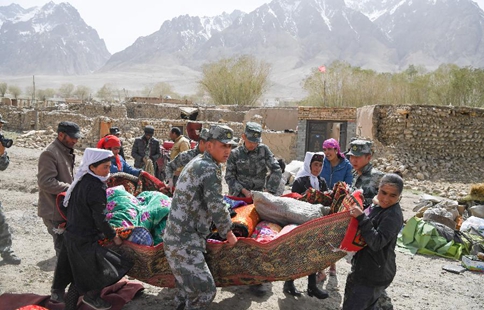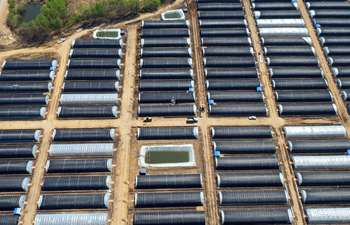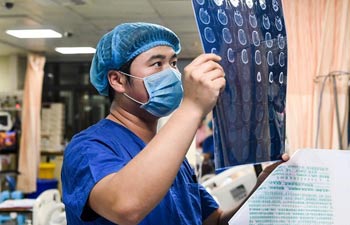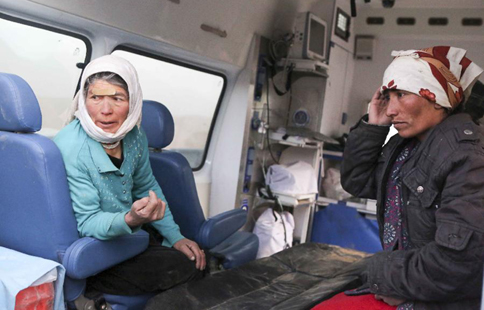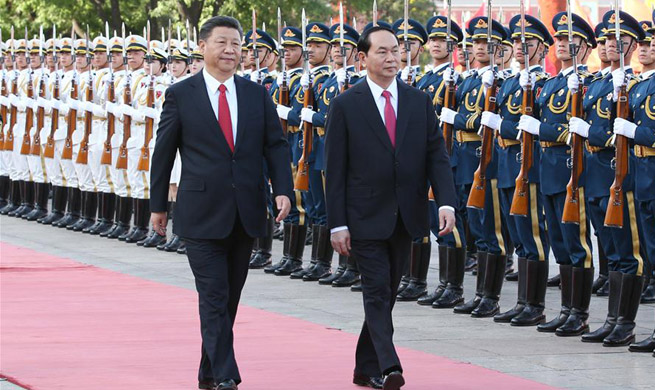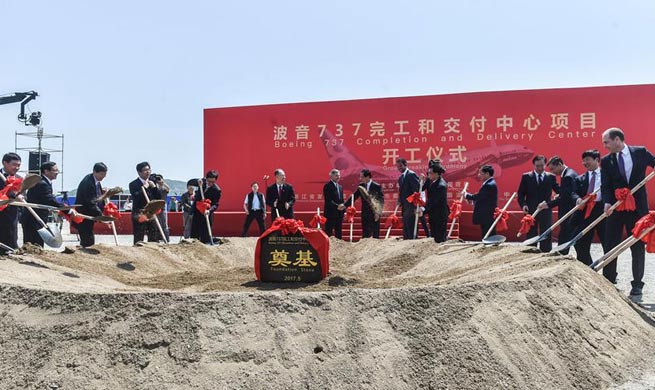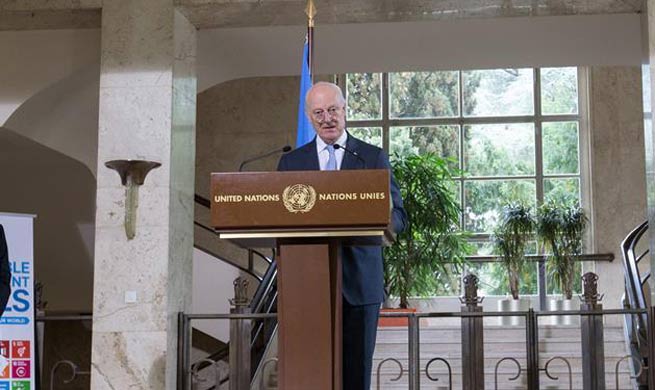BEIJING, May 12 (Xinhua) -- At the port of Gwadar in southwest Pakistan, Afchad runs a 30-square-meter Chinese convenience store. Dry noodles, sauces, and cans are stacked at the corner, and various snacks are displayed in glass cabinet, including spicy tofu cooked gluten, a popular Chinese specialty food.
A lot of Afchad's clients are Chinese, who are the builders of the China-Pakistan Economic Corridor, a cooperation program under the Belt and Road Initiative proposed by China in 2013. Thanks to the project, Gwadar, once a costal fishing town, has now been drawing investors in flocks.
The implementation of the initiative has brought significant changes for the daily life of Afchad and other people in Gwadar.
FROM QUERYING TO CHASING
For those who live in Kantone, a small village in Myanmar, long-awaited electricity has become a reality, due to a copper mine project facilitated by the Belt and Road Initiative.
"We watch TV everyday; we have air conditioners. These were completely unimaginable in the past," said Pu Maung, a local resident.
However, villagers were not cooperative at the beginning.
The Letpadaung copper mine project in Monywa, Myanmar, was launched in 2012 by China's Wanbao Mining Copper Ltd. Its construction had been repeatedly interrupted by protests from some local people dissatisfied with the land takeovers and concerned over potential environmental impact.
Wanbao made great efforts to win over the local people's understanding and support, sooth concerns, solve problems and offer a series of measures benefiting their livelihood. The copper mine was finally put into operation in March 2016.
Now, all the 33 villages near the site of the copper mine, no matter relocated or not, have electricity. This is not usual in Myanmar, where frequent blackouts occur due to a lack of electricity, even in big cities.
In order to help villagers overcome poverty, the Chinese company also taught them job skills, and provided start-up capital for some villagers to set up brick factories, cement plants, chicken farms and trailer teams.
Wanbao has also hired a mobile medical team from Yangon to provide medical services to the local communities.
In recent years, villagers have seen their income significantly increased and medical services and infrastructure greatly improved. Those who used to oppose the Letpadaung project now compete to work for it. A position at the copper mine may attract as many as 100 applicants.
FROM SURVIVAL TO PROSPERITY
"Thanks" has been the word repeated many times by Pablo Cordova during his chat with Chinese President Xi Jinping on Nov. 18, 2016.
"I want to express my heartfelt gratitude to Mr. President for your country's aid to Ecuador," the 52-year-old told Xi at the ECU-911 headquarters in Quito.
A year ago, a 7.8-magnitude earthquake hit the South American country and killed more than 600 people, marking it the worst in 70 years.
The quake flattened the hotel where Cordova worked in Portoviejo, a city in the western Manabi province. He had been trapped under debris for 46 hours before being rescued thanks to an ECU-911 call.
The nationwide ECU-911 system, constructed by a subsidiary of China Electronics Corp., is a relief command center in response to disasters. But in daily life, it works as a security network as well. Currently, there are 16 ECU-911 centers across the country.
For Cordova of Ecuador, Chinese technology saved his life; for Lotfy Rajae of Tunisia, Chinese technology is the start of his entrepreneurship and the foundation of his successful career.
Twenty-six years ago, Rajae was 18 and had learned some mechanical repairing skills from his father. He was recruited by Sinohydro Corp., a Chinese state-owned enterprise.
"Chinese mechanics are highly skilled. I learned from every one of them and gradually became an expert mechanic myself," Rajae said. The engineering computation methods he had learned from his Chinese colleagues laid a solid foundation for his career, he added.
Rajae now owns diversified properties in Tunisia, including the just-opened Forest Club, which covers more than 20,000 square meters and boasts various sports facilities. His business covers real estate development, municipal projects construction, auto trading and advertising.
In 2015, Rajae and Sinohydro succeeded in a joint bidding for a construction project of a large dam in the west of Tunisia. After starting out as a mechanic, Rajae had risen through the ranks to become a partner of Sinohydro.
"Sinohydro is just like my mother; without it, I would never be who I am today," Rajae said.
FROM CONNECTIVITY TO RECIPROCITY
Eying neighboring China as a big consumer, an increasing number of Russian fishermen have exported seafood, such as king crabs and lobsters, to China over the past few years, said Kareyev, a fisherman who has been working in Vladivostok for years.
Vladivostok is the administrative center of the Primorsky region in the Russian Far East. The Belt and Road Initiative has been welcomed by the region's government, governor Vladimir Miklushevsky told Xinhua.
The region and China share a common borderline stretching as long as 1,100 km. Two transit corridors -- one linking the Nakhodka Port with China's Heilongjiang Province and the other connecting the Zarubino Port with China's Jilin Province -- are under construction in order to connect Asia with Europe, boost products and personnel exchange and promote economic development.
The checkpoint on the border between China's Suifenhe city in Heilongjiang Province and Russia's Pogranichny town in Primorsky is crowded with Russian freight trucks, which cannot wait to enter China loaded with wood, seafood, oil and other products.
Sergey, one of the truck drivers at the checkpoint, told Xinhua that he usually makes one round trip per day in winter, and two when it gets warmer.
For Kazakh freight driver Daulet, here is something to his great excitement: the overhaul of an old bumpy road from Almaty, the capital of Kazakhstan to Horgos, a border city in China's Xinjiang Uygur Autonomous Region.
"The eight-to-nine-hour drive from Almaty to Horgos would be shortened to five or even four," Daulet said, noting that he wants to drive to Xinjiang when the project is completed.
The road is part of a trans-regional highway that links Lianyungang in East China's Jiangsu Province and St. Petersburg, Russia. It's an infrastructure project under the Belt and Road Initiative. It also links the European road network.
Stronger transport ties have enabled a more stable goods supply for Kazakh merchants and a greater selection of food products in the supermarkets. Agricultural products imported from China, such as leeks, cowpeas and garlic shoots have been diversifying the Kazakh people's winter diet, which used to include only cabbages, potatoes and carrots.
At the other end of the transport link, the Chinese people are getting familiar with Kazakh specialties such as camel milk and horse meat sausages. The expansion of modern infrastructure service under the Belt and Road Initiative is improving the income of local residents in participating countries.




